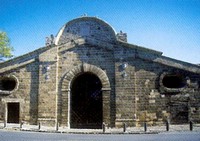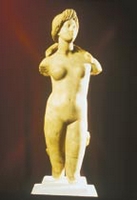Receive our newsletter
Your e-mail address is only used to send you our newsletter and information about the activities of Strasbourg Europe. You can always use the unsubscribe link included in the newsletter.
 A province of the Ottoman Empire since the 16th century, in 1878 Cyprus came under the supervision of Great Britain, who annexed it in 1914. The island officially became a colony of the British Empire in 1925.
A province of the Ottoman Empire since the 16th century, in 1878 Cyprus came under the supervision of Great Britain, who annexed it in 1914. The island officially became a colony of the British Empire in 1925.
Temple of Apollon, Kourion © Tourist office of Cyprus
 Built on the site of a town dating from the 2nd millennium BC, Nicosia only became the capital of the island during the 11th century, under the reign of the Frankish Lusignan dynasty. Nicosia has been divided since 1974 by the “green line”, a demarcation line between the Turkish and Greek zones. Consequently, it is the only European capital to be cut in half. In the North, the Turkish town, with its peaceful provincial charm, includes most of the monuments from the Frankish period, such as the Cathedral of Saint- Sophia, which has today become a mosque. The Greek part has retained its old districts, surrounded by Venetian ramparts dating from the 16th century, but has also become a major modern and dynamic economic and political center. Numerous historical and religious monuments (the cathedral, the mosque and Venetian buildings) are located in the old town, inside the walls, whose three main gates are now key landmarks. The richness of Nicosia’s cultural heritage reflects the various influences during the history of the island. Nicosia also boasts a number of museums, including the Museum of Cyprusm which is home to ceramics from the Neolithic period, the Byzantine Museum, which has a superb collection of icons, and the Archaeological Museum and its maze of galleries.
Built on the site of a town dating from the 2nd millennium BC, Nicosia only became the capital of the island during the 11th century, under the reign of the Frankish Lusignan dynasty. Nicosia has been divided since 1974 by the “green line”, a demarcation line between the Turkish and Greek zones. Consequently, it is the only European capital to be cut in half. In the North, the Turkish town, with its peaceful provincial charm, includes most of the monuments from the Frankish period, such as the Cathedral of Saint- Sophia, which has today become a mosque. The Greek part has retained its old districts, surrounded by Venetian ramparts dating from the 16th century, but has also become a major modern and dynamic economic and political center. Numerous historical and religious monuments (the cathedral, the mosque and Venetian buildings) are located in the old town, inside the walls, whose three main gates are now key landmarks. The richness of Nicosia’s cultural heritage reflects the various influences during the history of the island. Nicosia also boasts a number of museums, including the Museum of Cyprusm which is home to ceramics from the Neolithic period, the Byzantine Museum, which has a superb collection of icons, and the Archaeological Museum and its maze of galleries. Located 19 km to the west of Limassol, the Kourion Theatre is located in the heart of an ancient city-state of antiquity, on the island’s most important archaeological site. The excavations, which continue today, are constantly unearthing new discoveries, and bear witness to this rich heritage. Facing the sea, this Greco-Roman theatre was built in the 2nd century BC and then enlarged by the Romans in the 2nd century AD for use as a colloseum, in which fights against wild animals took place. In its day, the theatre could welcome 3500 spectators. Nearby, we find the ruins of an early Christian basilica which was probably the Cathedral of Kourion. Beautiful mosaic floors can be admired in the private villa of Eustolios, the house of Achilles and that of the gladiators (other remains from this ancient city). Today, the theatre has been fully restored and theatrical and musical events are held there. It attracts lovers of the ancient tragedies, who gather there during the Kourion Theatre Festival in July, a festival in which all the glory of Greek tragedy can be relived each evening in a setting worthy of these great works.
Located 19 km to the west of Limassol, the Kourion Theatre is located in the heart of an ancient city-state of antiquity, on the island’s most important archaeological site. The excavations, which continue today, are constantly unearthing new discoveries, and bear witness to this rich heritage. Facing the sea, this Greco-Roman theatre was built in the 2nd century BC and then enlarged by the Romans in the 2nd century AD for use as a colloseum, in which fights against wild animals took place. In its day, the theatre could welcome 3500 spectators. Nearby, we find the ruins of an early Christian basilica which was probably the Cathedral of Kourion. Beautiful mosaic floors can be admired in the private villa of Eustolios, the house of Achilles and that of the gladiators (other remains from this ancient city). Today, the theatre has been fully restored and theatrical and musical events are held there. It attracts lovers of the ancient tragedies, who gather there during the Kourion Theatre Festival in July, a festival in which all the glory of Greek tragedy can be relived each evening in a setting worthy of these great works.
Kourion Theatre © Tourist office of Cyprus

 Cyprus is also the legendary birthplace of Aphrodite, the goddess of beauty and love.
Cyprus is also the legendary birthplace of Aphrodite, the goddess of beauty and love.Your e-mail address is only used to send you our newsletter and information about the activities of Strasbourg Europe. You can always use the unsubscribe link included in the newsletter.
Information Center
on the European Institutions (CIIE)
Europe Direct Information Center
All rights reserved to the CIIE
Non-profit organization
Mailing address
1 allée Kastner
67000 Strasbourg
France
Visitors entrance
8 rue Boecklin
67000 Strasbourg
France
To provide the best experiences, we use technologies such as cookies to store and/or access device information. Consenting to these technologies will allow us to process data such as browsing behavior or unique IDs on this site. Failure to consent or withdrawing consent may adversely affect certain features and functions.
Europe Direct network
The CIIE team
Contact information and opening hours
Lieu d’Europe
The CIIE offices
Contact us
CIIE’s Documentation Centre & Publications
School presentations & Activities
Borrowing of learning material
Activities for the general public
Institutions of the European Union in Strasbourg
Institutions Under the Authority of the Council of Europe
Other European Organisations in Strasbourg
Sessions of the European institutions in Strasbourg
Visiting the institutions
Map of the European district of Strasbourg
Institutions in Strasbourg in photos
Discover artistic Europe
National holidays of the member states of the Council of Europe